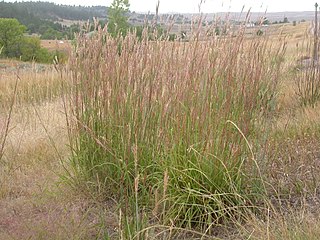
Andropogon gerardi, commonly known as big bluestem, is a species of tall grass native to much of the Great Plains and grassland regions of central and eastern North America. It is also known as tall bluestem, bluejoint, and turkeyfoot.

Ageratina altissima, also known as white snakeroot, richweed, or white sanicle, is a poisonous perennial herb in the family Asteraceae, native to eastern and central North America. An older binomial name for this species is Eupatorium rugosum, but the genus Eupatorium has undergone taxonomic revision by botanists, and some species once included in it have been moved to other genera.
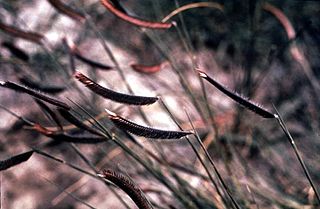
Bouteloua gracilis, the blue grama, is a long-lived, warm-season (C4) perennial grass, native to North America.
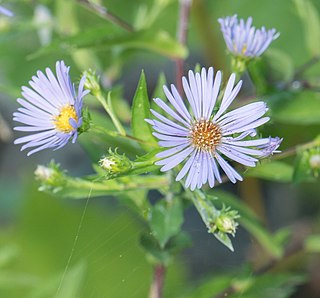
Symphyotrichum puniceum, is a species of flowering plant in the family Asteraceae native to eastern North America. It is commonly known as purplestem aster, red-stalk aster, red-stemmed aster, red-stem aster, and swamp aster. It also has been called early purple aster, cocash, swanweed, and meadow scabish.

Allium cernuum, known as nodding onion or lady's leek, is a perennial plant in the genus Allium. It grows in open areas in North America.

Polygonum erectum, commonly called erect knotweed, is a North American species of herbaceous plant in the buckwheat family (Polygonaceae). It is found primarily in the northeastern and north-central parts of the United States, but with scattered populations in other parts of the US and also in Canada.

Eupatorium hyssopifolium, also known as hyssopleaf thoroughwort, is a fall-blooming herbaceous plant native to North America. Like other members of the genus Eupatorium it has inflorescences containing a large number of very small flower heads, each with 5 white disc florets but no ray florets. At 0.5 to one meter tall, it is towards the shorter end of the range of heights found in Eupatorium species.

Tephrosia virginiana, also known as goat-rue, goat's rue, catgut, rabbit pea, Virginia tephrosia, hoary pea, and devil's shoestring is a perennial dicot in family Fabaceae. The plant is native to central and eastern North America.

Symphyotrichum pilosum is a perennial, herbaceous, flowering plant in the Asteraceae family native to central and eastern North America. It is commonly called hairy white oldfield aster, frost aster, white heath aster, heath aster, hairy aster, common old field aster, old field aster, awl aster, nailrod, and steelweed. There are two varieties: Symphyotrichumpilosum var.pilosum, known by the common names previously listed, and Symphyotrichumpilosum var.pringlei, known as Pringle's aster. Both varieties are conservationally secure globally and in most provinces and states where they are native.
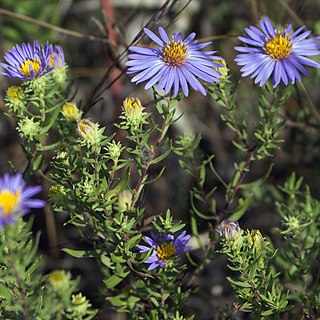
Symphyotrichum oblongifolium, commonly known as aromatic aster or oblong-leaved aster, is a species of flowering plant in the family Asteraceae and is native to parts of the eastern and central United States. It is an uncommon herbaceous perennial that reaches heights of 10–80 centimeters and blooms August–November with many flower heads in various shades of purple.

Borodinia serotina is a rare species of flowering plant in the mustard family known by the common name shale barren rockcress. It is native to eastern West Virginia and western Virginia in and around the Shenandoah Valley, where it is known from 62 populations. It is endemic to the shale barrens, a type of habitat characterized by steep slopes of bare shale, an exposed, rocky habitat type that is subject to very dry and hot conditions. Shale barrens host a number of endemics, such as Allium oxyphilum and Taenidia montana, and this rockcress is among the rarest. It is a federally listed endangered species.
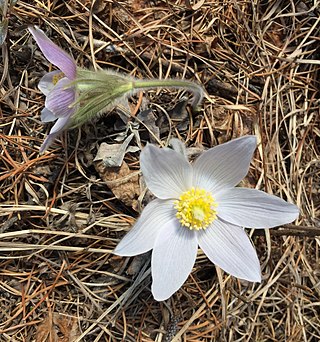
Pulsatilla nuttalliana, known as American pasqueflower, prairie pasqueflower, prairie crocus, or simply pasqueflower, is a flowering plant native to much of North America, from the western side of Lake Michigan, to northern Canada in the Northwest Territories, south to New Mexico in the southwestern United States. Pasqueflower is the provincial flower of Manitoba and the state flower of South Dakota.

Borodinia laevigata is a species of flowering plant in the mustard family known by the common name smooth rockcress. It is native to many areas of the eastern United States and Canada, where it grows in calcareous rocky woods and bluffs. It is moderately common throughout its range, although it is absent from the southeastern coastal plain and the far north.

Symphyotrichum dumosum is a species of flowering plant of the family Asteraceae commonly known as rice button aster and bushy aster. It is native to much of eastern and central North America, as well as Haiti and Dominican Republic. It is a perennial, herbaceous plant that may reach a height of 1 meter.

Solidago rigida, known by the common names stiff goldenrod and stiff-leaved goldenrod, is a North American plant species in the family Asteraceae. It has a widespread distribution in Canada and the United States, where it is found primarily east of the Rocky Mountains. It is typically found in open, dry areas associated with calcareous or sandy soil. Habitats include prairies, savannas, and glades.

Symphyotrichum shortii, commonly called Short's aster, is a species of flowering plant in the family Asteraceae. It is native to North America, where it is primarily found in interior areas east of the Mississippi River. Its natural habitat is in thin rocky soils of woodlands and thickets often around limestone bluffs. It is common throughout much of its range, although it is generally restricted to intact natural communities.
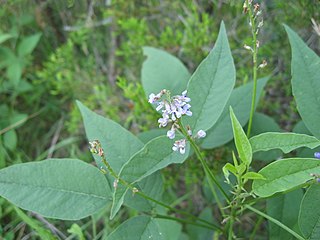
Orbexilum onobrychis, commonly called French-grass or lanceleaf scurfpea, is a species of flowering plant in the legume family (Fabaceae). It is native to the eastern United States where its range is concentrated in the Midwest and Upper South. Its natural habitat is primarily prairies and riverbanks, typically in mesic or wet areas. It is an uncommon species, and can be found in high-quality prairie remnants as well as more disturbed areas.
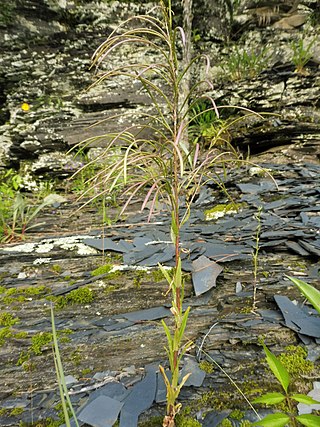
Borodinia missouriensis, commonly called Missouri rockcress, is a species of flowering plant in the mustard family (Brassicaceae). It is native to the eastern United States, where it has a highly fragmented range localized in the Northeast, the Upper Midwest, the Interior Highlands, and the Southeast. Its natural habitat is typically on rocky or sandy woodlands and bluffs, in areas of acidic soil. It is generally uncommon throughout most of its range, with exception for the Interior Highlands region.

Borodinia is a genus of flowering plants belonging to the family Brassicaceae. Species of the genus have a native range from southern Siberia and northern China, and from eastern Canada to the central and eastern United States.

Boechera patens, commonly called spreading rockcress, is a species of flowering plant in the mustard family (Brassicaceae). It is a short-lived biennial forb native to North America. Its natural habitat is xeric soil, often on calcareous substrates. It produces white flowers in the spring.





















